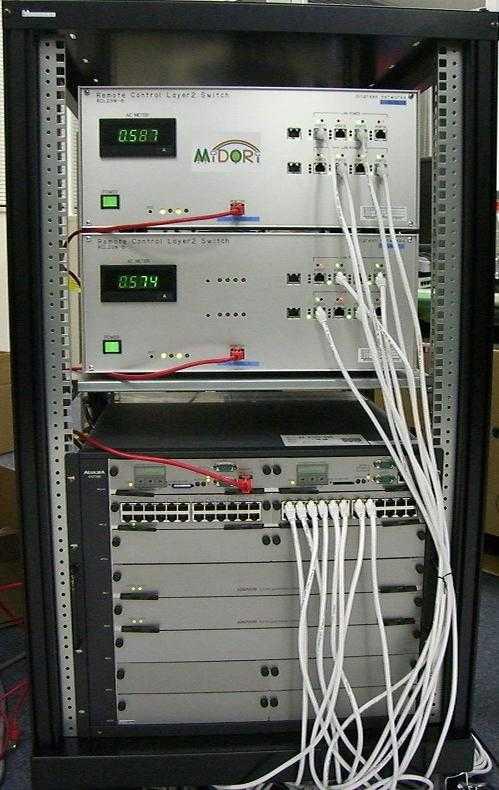On January 6, 2011, Japanese newspaper “NIKKEI SANGYO SHINBUN” picked up the success of an experiment about an energy efficient Ethernet switch network for a datacenter.
Yamanaka Lab. focuses on a self-organizing energy saving network which realizes the most energy-efficient network topology automatically based on traffic volume monitored at network devices.
When traffic volume is low, our proposed network makes as many links as possible idle by aggregating traffic. The power optimization of the overall network is executed autonomously by turning off ports of network devices (routers, Ethernet switches, optical cross connects) at the ends of idle links.
In this experiment, the self-organization of Ethernet switches network for a datacenter was succeeded. The experimental network consists of commercially produced Ethernet switches, green Ethernet switches developed by Keio Univ., and an energy saving network topology calculation system.
By adopting this self-organizing energy saving network system, about 15 percent reduction is expected in the power consumption of network devices in the data center.
This work is supported by PREDICT program of the Ministry of Internal Affairs and Communications (MIC) of Japan.
• NIKKEI SANGYO SHINBUN (Jan. 6, 2011) [Japanese]
*An access to this article is restricted by password.
[/lang_en]”,”[lang_ja]日経産業新聞(2011年1月6日)にもデータセンター向けイーサネット機器省電力化実験成功の関連記事が掲載されました[/lang_ja][lang_en]On Jan. 6, 2011, Japanese newspaper “NIKKEI SANGYO SHINBUN” picked up the success of an experiment about an energy efficient Ethernet switch network for a datacenter.On January 6, 2011, Japanese newspaper “NIKKEI SANGYO SHINBUN” picked up the success of an experiment about an energy efficient Ethernet switch network for a datacenter.
Yamanaka Lab. focuses on a self-organizing energy saving network which realizes the most energy-efficient network topology automatically based on traffic volume monitored at network devices.
When traffic volume is low, our proposed network makes as many links as possible idle by aggregating traffic. The power optimization of the overall network is executed autonomously by turning off ports of network devices (routers, Ethernet switches, optical cross connects) at the ends of idle links.
In this experiment, the self-organization of Ethernet switches network for a datacenter was succeeded. The experimental network consists of commercially produced Ethernet switches, green Ethernet switches developed by Keio Univ., and an energy saving network topology calculation system.
By adopting this self-organizing energy saving network system, about 15 percent reduction is expected in the power consumption of network devices in the data center.
This work is supported by PREDICT program of the Ministry of Internal Affairs and Communications (MIC) of Japan.
• NIKKEI SANGYO SHINBUN (Jan. 6, 2011) [Japanese]
*An access to this article is restricted by password.

